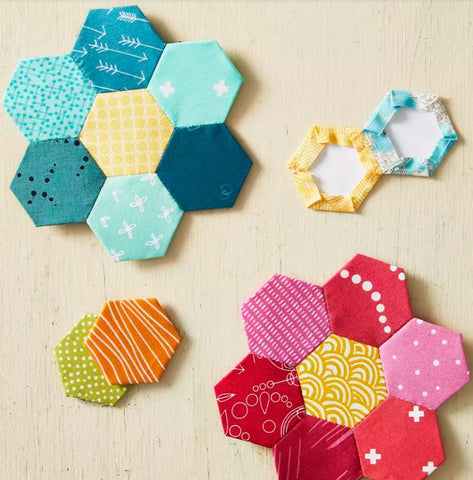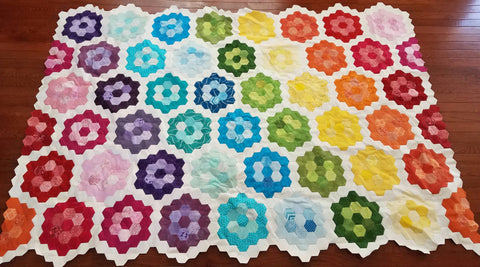How to create a quilt top
Piecing is the term given to the process of joining pieces of fabric together to make a patchwork panel for a quilt top. There are different techniques and in this post I will explain the most popular ones.
Machine piecing
This is the technique that I always use; I love working with my sewing machine to speed up the process and it makes me feel safer regarding the quality and sturdiness of my stitches.
When machine stitching you use your sewing machine to sew the different units together to create a block, that you then join to other blocks. The process itself is pretty simple but there are some things you can take into account:
1. Seam allowance: most quilts have a 1/4'' seam allowance. For this and to get the best results, I recommend using a quarter-inch presser foot and even better if it comes with a metallic guide (pictured below).

2. Pressing seams: if ironing while making a garment is important, it is even more so when piecing a quilt, which usually requires A LOT of precision.
As you can see, I said pressing rather than ironing when refering to quilting. When you finish a block or unit and need to press a seam (I prefer with seams open or facing to the darker colour), do it with gentle taps, full heat and NO STEAM. This way you won't be stretching or distorting the shape of the seam, unit or block.
I love using my mini iron from Prym for pressing single seams and individual blocks; I use the bigger one and the ironing board when joining big bocks together and when pressing the whole quilt top.
Apart from my mini iron, I also got a wool pressing mat which was a total discovery. Wool is an amazing insulator and it absorbs heat and then quickly releases it, "ironing" both sides of your fabric at the same time. The texture of the wool also grips the fabric in place. The main con? The mats are usually not very big.

English paper piecing
Also referred to as 'mosaic patchwork', English paper piecing is a hand sewing technique where the fabric is wrapped around a paper template to make individual patches. These are then hand-sewn together before removing the basting stitches and papers to create the quilt top.
The most popular shape is the hexagon and I am sure you have seen these somewhere.


I am too impatient for hand-sewing but I might give it a go for a small pouch in the future...
Paper piecing or foundation paper piecing
This technique is like the 'paint-by-numbers' of quilting. You use a paper template to outline which fabric goes where, then stitch (with your machine) both the paper and fabric together along dotted lines. You then remove the paper and you get a perfectly pieced block.

Paper piecing is ideal to achieve very accurate points (i.e. when piecing triangles) and it is widely used to create figurative images. This is the technique I want to properly learn and practice more next as I have an idea for a quilt design :)

Appliqué
Last on this post is the appliqué technique which refers to applying one piece of fabric to another. It can be used for adding accent to a quilt or putting together an abstract design. It is done by hand and the possibilities are endless! Take a look at some examples below.

And that's it for this post. I hope it was helpful and that you might consider any of these piecing techniques for your next quilt!
Thanks for reading,
Ana
xxx
Reference:
'Modern Quilt Bible' by Elizabeth Betts.
